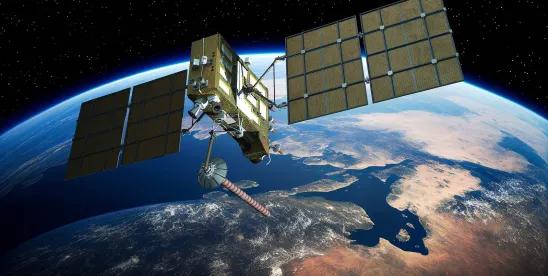We may imagine that a space company begins with only a few screws and some sheet metal in a garage.[1] But regardless of its origins, not long after that early phase, that same company is likely to have a global reach. Commercial space companies inherently involve elements such as international supply chains, foreign customers, and design and engineering talent from around the world.
For that reason, outdated U.S. export controls—regulations that restrict commercial space and satellite commodities, technology, and software as if they were military assets—can burden space companies of all sizes and, particularly, keep the smaller businesses from reaching competitive viability.
1. The October 2024 Space Rules
In response to that concern, on October 17, 2024, U.S. agencies overseeing exports in the space industry[2] issued an inspection copy of four new regulatory notices (the October 2024 Space Rules), each of which should reduce compliance burdens and potential confusion that space and satellite companies have faced in the past. All of the regulations appear to be aimed at modernizing U.S. export control regulations and keeping the U.S. commercial space industry competitive globally, as follows:
- A rule removing or exempting items from defense export controls, including, among others:
- Decontrolling spacecraft that can dock with commercial space stations, as well as spacecraft with autonomous collision avoidance
- Providing limited exemptions to items for certain space agency programs, space tourism, and space fundamental research
- A rule reducing and clarifying commercial controls on certain items, including, among others:
- Reducing controls on Export Control Classification Number (ECCN) 9A515.x, a catch-all for space-related parts, components, and accessories
- Clarifying rules on spacecraft and launch vehicle export controls
- Clarifying controls on vehicles in international waters
- A rule eliminating the export license requirements for certain spacecraft to Australia, Canada, and the United Kingdom.
- A rule adding a new export License Exception for Commercial Space Activities (CSA).
For those of you who wish to read ahead, we have provided links to each rule above. However, for those of you who can stand to wait (and who don’t mind our prose), we will provide summaries of each new rule throughout the week.
Below, please find our overview of the first October 2024 Space Rule, wherein DDTC removes and exempts numerous items from the ITAR.
2. Pulling Space-Industry Items Out of ITAR Control
When an item is subject to ITAR control, the export of that item (whether it is a commodity, technology, or software) may require a license to almost any country. So where an item can be removed or exempted from the ITAR, the companies dealing with that item gain flexibility in their use of international resources, collaboration, and markets. For that reason, the U.S. gains a substantial competitive advantage in the development, production and sale of each item that is removed from the ITAR to the control of the EAR or for which an exemption is provided in certain circumstances.
In the first of the October 2024 Space Rules, DDTC revises the U.S. Munitions List (USML) Category IV (which covers launch vehicles), and Category XV (which covers spacecraft and related articles) to decontrol spacecraft with functions that are becoming increasingly the norm, and to exempt or license exports for activities that are more commercial or that support government programs. We highlight some of the notable changes.
3. Revisions to the USML – Spacecraft Getting Together and Keeping Apart
The rule will make it easier for (some) spacecraft to get together. The DDTC rule removes, from ITAR controls, spacecraft capable of servicing other spacecraft through grappling and docking with a non-NASA Docking System. Those spacecraft were formerly described in USML Category XV(a)(12). As the commercial space industry develops more and varied spacecraft that are capable of docking with a range of commercial space stations without using a NASA docking system, those spacecraft would no longer be controlled under the ITAR. Rather, USML Category XV(a)(12) would be revised to focus exclusively on surveillance spacecraft.
However, a spacecraft capable of docking with another without cooperation will now be subject to the ITAR under a new control introduced in this new rule (one presumes because if that docking can be accomplished without cooperation, then it may be accomplished where the party of the second part does not want the party of the first part to accomplish that docking.)
The rule will also make it easier for spacecraft to stay apart (both from other spacecraft as well as debris, satellites, and anything else that might disturb their flight path). The DDTC rule removes from ITAR controls spacecraft that autonomously perform collision avoidance maneuvers. This decision recognizes the increasing necessity for spacecraft to execute avoidance maneuvers due to the escalating congestion in space, and demonstrates an understanding that autonomous avoidance capabilities no longer constitute a significant military or intelligence advantage.
Finally, the rule clarifies that commercial low Earth orbit (CLEO) habitats are not subject to ITAR control, but that electronic parts and components capable of operation at temperatures in excess of 125 °C and specially designed for spacecraft are subject to ITAR control (in USML Category XI(c)(15)).
4. Civil Space-Related License Exemptions and Special Licensing Provisions
4.1 Exemption for Certain Official Space Agency Programs
DDTC’s proposed new license exemption authorizes certain transfers of defense articles and defense services when conducted entirely within the scope of an official U.S. government agency space program. The proposed rule specifically identifies NASA’s Lunar Gateway, NASA’s Mars Sample Return, Nancy Grace Roman Telescope,[3] and the Orion Spacecraft. However, we note that this exemption is subject to certain restrictions and does not extend to the space launch vehicles associated with these spacecraft.
4.2 Exemption for Certain Space Activities
Furthermore, DDTC proposed a license exemption for certain space activities including the following: (1) transfers of defense articles and defense services supporting space launches; (2) services related to the transmission of space launch vehicle telemetry; (3) services to support collaboration with foreign persons when on-orbit defense articles are utilized in support of fundamental research; and (4) services associated with radiofrequency transmissions using on-orbit defense articles.
While some of the items and activities here are described as defense articles and defense services, they are largely ITAR-controlled items and services that are often used in the pursuit of commercial activity. By providing license exemptions for launches, telemetry information, fundamental research, and communications, the DDTC is lowering the burden for sharing those largely non-defense items and services across borders without the burden of obtaining ITAR authorizations.
4.3 Space Tourism and Research Exemption
Additionally, DDTC is introducing an exemption that would authorize certain transfers of manned spacecraft for space tourism or in support of fundamental research similarly described in the EAR’s new License Exception CSA (to be covered in an upcoming article!).
4.4 Licensing of Defense Articles Incorporated or Integrated into EAR Spacecraft
Finally, the proposed rule allows certain spacecraft systems, equipment, propulsion systems, power systems, and parts, components, accessories, and attachments to be licensed for export, reexport, or retransfer by BIS while they are incorporated in and included as an integral part of a spacecraft subject to the EAR. That provision will simplify the licensing process for exports of items that combine EAR- and ITAR-controlled items and will make it easier for space industry companies designing, developing, manufacturing, selling, or launching those items to move them across borders.
5. Status of the Rules
DDTC’s proposed rule largely revises ITAR USML Categories IV and XV and will be published in the Federal Register on October 23, 2024. Comments for the proposed rule must be received by DDTC no later than Friday, November 22, 2024.
BIS published revisions and additions to its space-related export controls which are detailed in a an interim final rule (IFR), a final rule, and a proposed rule. The IFR and final rule will be effective October 23, 2024. Comments for the IFR and proposed rule must be received by BIS no later than Friday, November 22, 2024.
6. More to Follow
In the following days, we will publish Parts II, III, and IV of this series, summarizing the other final, interim, and proposed rules that make up the October 2024 Space Rules.
We welcome your questions and comments at the contact information of the authors.
FOOTNOTES
[1] We understand, from our exhaustive research, that time-travel industry companies apparently also tend to begin this way. See, e.g. Back To The Future (Universal Pictures 1985); Bill & Ted’s Excellent Adventure (De Laurentis Entertainment Group 1989)
[2] The U.S. Department of State Directorate of Defense Trade Controls (DDTC) which promulgates and enforces the International Traffic in Arms Regulations (ITAR), and the U.S. Department of Commerce Bureau of Industry and Security (BIS) which promulgates and enforces the Export Administration Regulations (EAR).
[3] Not the similarly-named television presenter, but this woman (https://science.nasa.gov/people/nancy-roman/) whom, if we may indulge in editorializing, we admire greatly.





 />i
/>i

